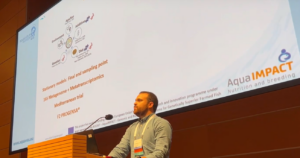An AquaIMPACT study on the gut microbiota of gilthead sea bream was nominated for the Student Spotlight Award in the Aquaculture Europe 2022 conference.
The annual Aquaculture Europe international conference celebrated its 22nd edition in Rimini, Italy (September 27-30th) and, as usual, the organization selected the three most interesting and high-quality abstracts presented by students. This year, Fernando Naya-Català, a PhD student of the Nutrigenomics and Fish Endocrinology group of the Institute of Aquaculture Torre de la Sal (IATS-CSIC), was nominated to this award.

Fernando Naya-Català showed the main outcomes of the nominated work in the Aquaculture Europe 2022 conference. Source: www.mispeces.com.
The research presented by Fernando focused on the regulation of gut microbiota by genetics and nutrition, and how the adherent gut microbiota can interact with host at the transcriptional level to modulate a wide range of biological processes for preserving and improving gut health and growth performance along a 12-month production cycle.
The trial was conducted in Canary Islands by AquaIMPACT partner ULPGC (Universidad de Las Palmas de Gran Canaria), and fish fed with aquafeed made by the AquaIMPACT company partner Skretting ARC were sampled three times throughout the production cycle for 16S sequencing and host transcriptomic analyses at IATS-CSIC.
Genetics and nutrition drive gut microbiota diversity
Such approach served to disclose a core gut microbiota of 16 bacteria genera across fish having different genetic backgrounds. However, genetically selected fish for accelerated growth displayed a less variable microbiota, which was also more plastic for dealing with changes in diet composition.
At the same time, fast growing fish disclosed wider transcriptomic differences when facing changes in diet composition as part of their functional advantage in a challenging environment. These microbiota features corroborated previous results of the IATS-CSIC research group with the same fish source in fish farmed in the Mediterranean basin.
Lastly, correlation analyses of gut bacteria abundances and host intestinal gene expression profiles contributed to disclose what nutritionally mediated changes on host transcriptomics can be independent or mediated by changes in gut microbiota, opening new research opportunities for physiologists and nutritionists.
All this together reinforces the potential use of gut microbiota as a reliable tool in selective fish breeding for improving fish performance and resilience in a context of climate change and reduced availability of marine feedstuffs and conventional alternative raw materials, which will require new fish feed formulations for promoting a more sustainable aquaculture.
Reference:
Naya-Català F, Piazzon MC, Torrecillas S, Toxqui-Rodríguez S, Calduch-Giner JA, Fontanillas R, Sitjà-Bobadilla A, Montero D, Pérez-Sánchez J. Genetics and nutrition drive the gut microbiota succession and host-transcriptome interactions through the gilthead sea bream (Sparus aurata) production cycle. Biology 11:1744 (2022). https://doi.org/10.3390/biology11121744.
